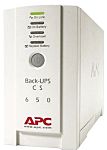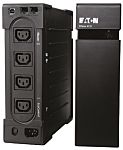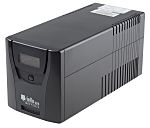
|
What is a UPS power supply?
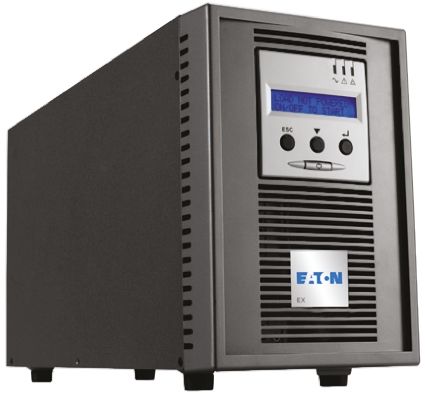 The core role that any UPS power supply aims to perform is that of a secondary power source - effectively an on-demand, instant-switch battery backup - for computers and other memory-based tech hardware.
The core role that any UPS power supply aims to perform is that of a secondary power source - effectively an on-demand, instant-switch battery backup - for computers and other memory-based tech hardware.
PCs are filled with valuable but delicate hardware components that are often vulnerable to damage caused by sudden loss of power. A quality UPS system is designed to protect them (and the data they rely on) in the event of a blackout, mains surge, or other atypical power event.
UPS units are becoming increasingly popular as add-on peripherals found in home and work PC setups, server and network environments, and in many other hardware-critical computing applications. In these sorts of scenarios, uninterruptible power supplies offer computer users additional peace of mind and an extra level of safety for both their hardware and their data,
In this guide to UPS battery systems, we’ll examine exactly what it is a UPS does, and how they help to protect expensive and delicate high-end computer components from the potentially damaging effects of sudden mains power failures, electrical surges and other causes of unexpected shutdowns. We’ll also explore some of the various types of UPS power supplies available on today’s market, to help you decide which sorts to focus on when looking to make a UPS purchase.
A quick note on naming conventions: in the context of tech hardware, the acronym UPS actually stands for uninterruptible power supply, and so technically the phrase ‘UPS power supply’ is a handy example of RAS syndrome (along with ‘PIN number’ and ‘LCD display’)! However, it remains a very commonly used term among customers and suppliers alike, and so for the purposes of this guide we’ll use both the standalone acronym and the longer version interchangeably.What is a UPS battery?
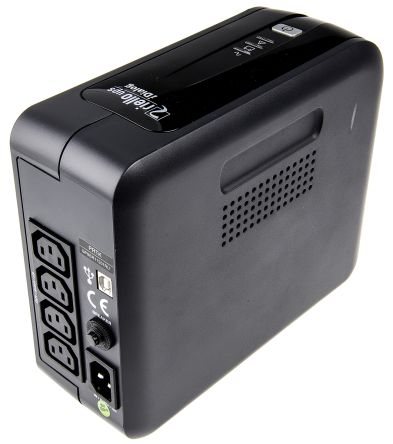
UPS power supplies generally sit between the mains wall socket and the computer being powered, plugged in to each via separate cables. Depending on the specifics of its intended usage environment and its overall power capacity, the average home or office UPS battery backup is typically a relatively small and compact ‘smart’ unit, built around a high-drain rechargeable power cell.
Traditionally, this will most often be a lead acid (VRLA) battery, but ongoing developments in lithium ion technology also mean that Li-ion cells are now becoming increasingly widespread components at the heart of modern UPS systems.
VRLA or lead acid batteries tend to be fairly low-maintenance and are generally viewed as basic, reliable UPS power supply workhorses with a typical 5-year lifespan. The ‘VR’ in VRLA stands for valve regulated, referring to the fact that VRLA batteries have built-in, automatically operated vent systems for controlling the release of gradual gas buildup at certain points in the battery charge-drain cycle. This important function is triggered by internal pressure sensors, and - like most aspects of VRLA cell types - performs best when the battery is kept in a dry, temperature-controlled environment, such as an average centrally-heated room in a home or office.
Li-ion UPS batteries, by contrast, are generally far more compact and lightweight, and can boast a range of built-in power management features - such as advanced charge and voltage balancing - to boot. Many brands also offer a somewhat longer expected lifespan than lead acid batteries on the whole, meaning that over a long enough timeline they may end proving a similarly economical choice. Up front, however, UPS units featuring Li-ion batteries tend to be priced to reflect their significantly higher production costs, and so initial buy-in will usually be cheaper for a VRLA-based unit.
There is also a third option for UPS batteries, namely ‘wet/flooded cell’ or VLA types. These are much less widely available as purchasable options in high street or off-the-shelf UPS systems, as they’re intended for quite specific applications and environments. For one thing, their chemical makeup means they’re potentially hazardous unless kept in entirely separate battery storage saferooms, and they also require regular user maintenance in terms of topping up their distilled water levels and continual monitoring of their equalisation and calibration data.
While this makes VLA batteries utterly impractical for the vast majority of home users and even most office environments, wet cells can offer distinct advantages in certain specific use cases - such as large-scale server centres - where excellent long-term reliability and stability are the key requirements above convenience or practicality.
In addition to the battery and housing itself, UPS power supplies generally include a range of other useful features, largely dependent on the model (and overall cost) of the unit. These might include such elements as:
-
-
- Advanced on-board performance monitoring software
- Management card slots and other data-reading functionality
- Deep discharge, power surge, low voltage and/or temperature protection
- LCD/OLED display screens and readout panels
- Graphical calibration interfaces
- A broad range of connectivity and external hardware I/O expander (input/output) options
- Variable numbers of power sockets and outlets
- ‘Hot swappable’ battery replacement and/or live UPS maintenance options
- Various IP ratings
-
What does a UPS do, and how does it work?
As noted in the introduction to this guide, the core function of a UPS unit above all else is to provide a temporary source of constant - i.e. ‘uninterruptible’ - power to a computer setup or other important hardware array, even in the case of a mains blackout or similar electrical disruption.
Importantly, a UPS is not intended to provide long-term backup use of connected devices for extended periods without power; UPS units are not designed to offer a battery-operated solution for continuing to work or browse the internet ‘off-grid’, so to speak.
Rather, in a scenario where the regular power source is suddenly removed, the point of UPS units is provide a limited window of time in which the user can still perform a controlled shutdown (in accordance with standard operating guidelines) of the device in question, in response to mains power no longer being available.
We’ll examine exactly how this works in a subsequent section, but an extremely simplified version is that the UPS power supply collects and stores some of the power being drawn from a wall socket in its onboard battery, before sending the rest on to the computer as normal.
If and when that flow of electricity coming from the mains socket is then suddenly stopped for any reason - typically in the case of a power cut, but equally due to the accidental unplugging of a cable or similar - the UPS can instantly switch over to sending out the backup power stored in its internal battery instead.
Hardware damage vs data loss
The point of all this is that a UPS protects vulnerable (and often expensive) hardware components from physical or memory-based damage if they’re suddenly brute-disconnected from the main power circuit for any reason. And, arguably even more importantly, having a UPS unit installed should also mean that vital data isn’t lost or corrupted due to a total power-off event mid-transfer.
With most day-to-day PC activities, the risk of permanent data error/loss in the event of any unexpected process interruption is actually reasonably high - that’s why there’s usually an approved disconnect procedure for almost any type of data transfer activity. (Even for something as simple as removing a memory stick from a laptop’s USB socket, you’ll generally be asked to click a button and await the ‘ok to remove’ message before disconnecting the two devices.)
Conversely, if you simply yank a peripheral out of its socket the moment it looks like your last photo or document has transferred over successfully, the PC (or the storage device itself) may not quite have finished writing all the data it needs in order to make those files fully readable by both parties in future.
In the worst case scenarios, this can lead to the files becoming unreadable by devices at both ends of the transfer process. Data that’s been damaged or corrupted in this way can sometimes still be salvaged by a specialised recovery technician, but if they’re unable to repair or retrieve it (often at substantial cost), then it can effectively be lost forever.
Of course, that’s one of the key reasons to always keep backups of important files - but that only really applies to YOUR data, which is usually kept in formats designed to be moved around on a whim. By contrast, more integral background transfer processes are constantly happening at both hardware and operating system level any time computer is powered on and running - many of which are absolutely key to the machine’s ability to function.
In the case of sudden power loss, it’s the interruption of these core processes that can irreparably damage even a simple desktop PC, which is what the UPS power supply exists to prevent.
Types of UPS power supply
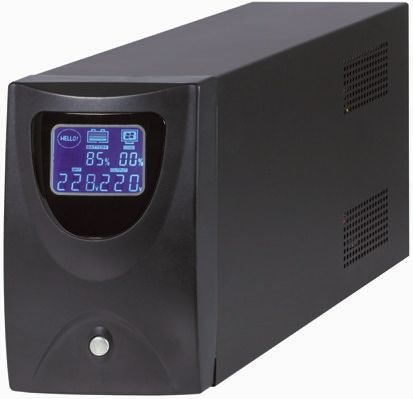
As we alluded to earlier in this guide, there are various different sorts of UPS systems available on today’s market. Regardless of what model or brand you eventually opt for, you’ll find a very wide array of different features and configurations on offer, ranging from numerous connectivity interfaces to built-in display screens, software management packages and more.
However, these bonus features shouldn’t be confused with the important issue of selecting the right core type of UPS unit to begin with - luckily, the choice essentially boils down to a few key variants. In this section, we’ll look at each of the main types in turn, and try to work out which UPS power supply you need in order to best suit your hardware setup and operating requirements.
Online UPS
An online UPS system might be considered the top-end option for most usage scenarios: it’s typically the most costly type of UPS power supply, and offers the greatest security against unexpected current fluctuation or sudden power loss.
The term ‘online UPS’ has nothing to do with internet connectivity as you might expect; rather, a fully online UPS power supply (often called a ‘true UPS’) refers to one that is constantly filtering, storing and delivering electrical flow to your PC, even when all conditions are normal.
In short, an online UPS is always performing the task it was designed to perform, rather than only jumping to action when needed - which of course means that, in the event of sudden power loss, there is genuinely zero interruption as far as the computer is concerned, and the supply of clean, stable power continues as if nothing happened.
While this offers by far the most seamless and safest (from a hardware/data perspective) option in terms of protection for computers and their components, it also means that power draw and running costs are considerably higher for this type of UPS unit - not to mention the significantly increased cost of the technology itself.
Naturally, this can be of considerable value in certain critical roles and environments, where any performance or data loss would be catastrophic, but for most home users it might be considered overkill. That said, while online UPS systems were once extremely costly investments for high-end business networks only, in recent years they have become a lot more affordable for enthusiast home users keen to buy into the most comprehensive protection for their own systems and files.
Offline/Standby UPS
In contrast to the version outlined above, an offline or standby UPS does exactly what you’d imagine from the name: rather than constantly cycling, storing and converting power through to a computer or server, it ‘idles’ until absolutely needed.
In practice, whenever the standby UPS detects that electricity flow from the wall socket is registering as normal, it effectively allows itself to be bypassed. The instant it detects a problem - which is usually within 5 milliseconds for most quality models and brands - the offline UPS power supply switches over to its internal battery backup instead.
Although that 5 milliseconds usually puts it well within tolerance range for most home-use, consumer-grade electronics, it does nevertheless count as a very slight ‘interruption’ - which is why offline models aren’t technically considered ‘true’ UPS devices by professional users. However, they tend to be a perfectly functional (and much more cost-effective) stand-in for most domestic desktop PC owners, and are only really seen as unsuitable in very critical applications where any risk of data or hardware loss is unacceptable.
Hybrid/line-interactive UPS
Based on each of the above definitions, it won’t surprise you to learn that hybrid UPS systems - which often includes so-called ‘line-interactive’ UPS units - offer something of a middle-ground solution, and an effective balance between cost and performance.
Whereas an online UPS constantly cycles power through its battery, and a standby UPS system switches over to battery power only if and when it detects a problem, a hybrid or line-interactive UPS power supply offers various operating modes. These generally include double conversion mode, economy mode, and active filter mode - and the hybrid UPS is able to detect which is most appropriate at any given moment. This approach is achieved through a variable power transformer system, and means that total power draw over any typical period of extended use is much lower than for a fully online equivalent.
Moreover, during ‘brownout’ scenarios - which are much more common than full blackouts, and involve potentially damaging fluctuations in current rather than a total loss of power - the line-interactive UPS is far more effective at monitoring, managing and adjusting to flow variations than an offline version.
The hybrid model will not continually have to switch between supplying wholly mains or battery power, meaning long-term health of the battery is greatly increased and further strengthening the overall value proposition of a line-interactive UPS.
Which UPS should you buy? Power load, runtime and more
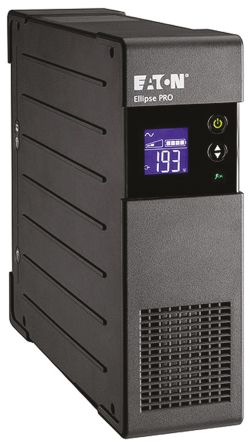
When it comes to the question of how to buy and use the right model, brand, and ‘size’ or capacity of UPS for your needs, there are a few key factors to take into account. Regardless of whether you’ve opted for an online, standby or hybrid type UPS power supply, in the main these will be:
-
-
- The types of circuit protection you need - different models and configurations offer various combinations of safety features, including some or all of the following:
- Blackout protection
- Brownout protection
- Surge protection
- Over-voltage protection
- Under-voltage protection
- Deep discharge protection
- Harmonic distortion protection
- Frequency variation protection
- The amount of UPS power you need, i.e. the UPS capacity - this will basically involve working out:
- How many devices you’re going to be plugging into it
- What the combined total power draw (electrical load) of those devices is, expressed in wattage
- How long you need to be able to run those devices for in the event of a blackout
- The runtime of a UPS will depend entirely on the size of its battery, and how many devices that battery is being asked to support if the mains power goes out
- The runtime of any given UPS power supply will therefore be a calculation between capacity and load
- As an absolute baseline, you’ll need to figure out the bare minimum amount of time you’d need to access your computer(s), finish/stop and save any active processes, and shut it all down properly
- The types of circuit protection you need - different models and configurations offer various combinations of safety features, including some or all of the following:
-
When shopping for a UPS system, other factors you may want to consider - which are generally less crucial than the ones listed above, but may still influence your purchasing decisions - include the looks of the unit (if it’s going to be on display along with other hardware components), its overall physical size and form factor, and where in your home or office it’s likely to be positioned for best access and safety.
Product spotlights
Shop our most popular brands of unintrerruptible power supllies:

